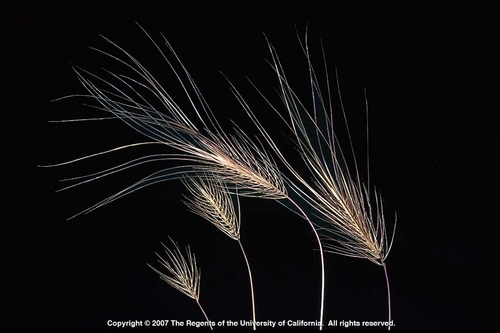Medusahead (Taeniatherum caput-medusae) and barbed goatgrass
(Aegilops triuncialis) are noxious annual weeds that rapidly invade grassland, savannah and woodland ecosystems of the western US. Both are found extensively in Mendocino and Lake Counties with Medusahead being the most prevalent. While livestock will eat the early vegetative stages of both these grasses they are not as palatable as other grasses. Once awns are formed very little consumption takes place and these awns help spread the seed through attachment to the grazing livestock and wildlife. Herbicidal control is difficult as most herbicides that attack these pests will also kill the desirable species and is probably not economical. Both of these weeds tend to spread and block out more desirable forages and actually devalue the carrying capacity of the range.
Researchers Jimin Zhang, Tag Demment, Craig Schriefer, Corey Cherr and Emilio Laca at UC Davis sought to develop effective and economical strategies for controlling Medusahead and barbed goatgrass that would not damage more desirable species. In their work they applied precision mechanical defoliation at three intensities (3, 6, and 9 cm stubble height), and nine times (April 15, 19, 25, 28, and May 1, 4, 8, 12,16, 2007) before Medusahead and barbed goatgrass seeds had reached maturity.

As a result of these mowing treatments plants did exhibited some regrowth, but Medusahead seed production was practically eliminated by mechanical defoliation to 3 and 6 cm height during the R4 and R5 growth stages. These growth stages are when the awns and anthers, respectively, become visible. Mechanical defoliation at the same ranges of height and growth stage also reduced barbed goatgrass seed production by 95 % or more. Where geography permits, the use of temporally precise mowing is an effective tool to control these rangeland weeds.

